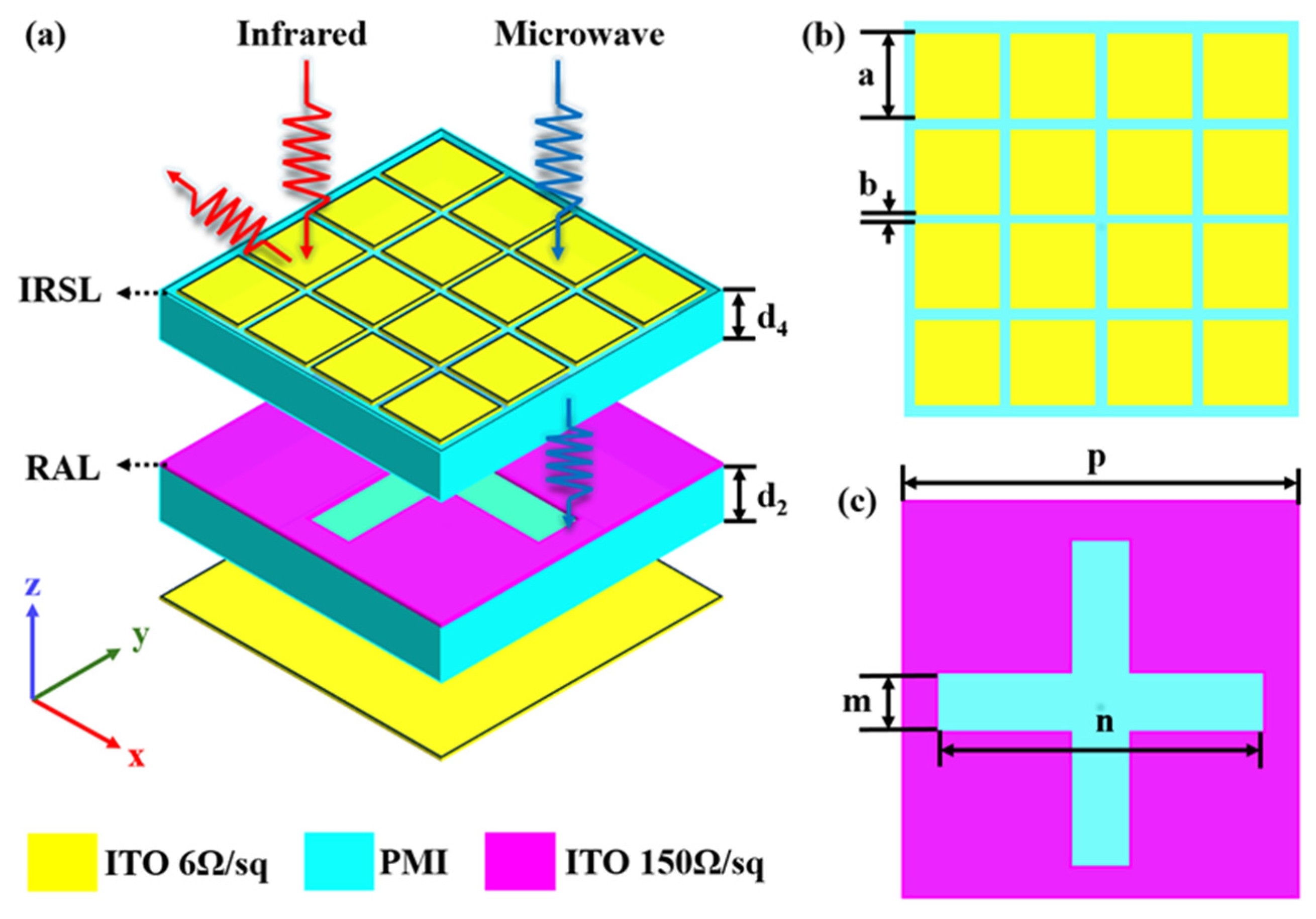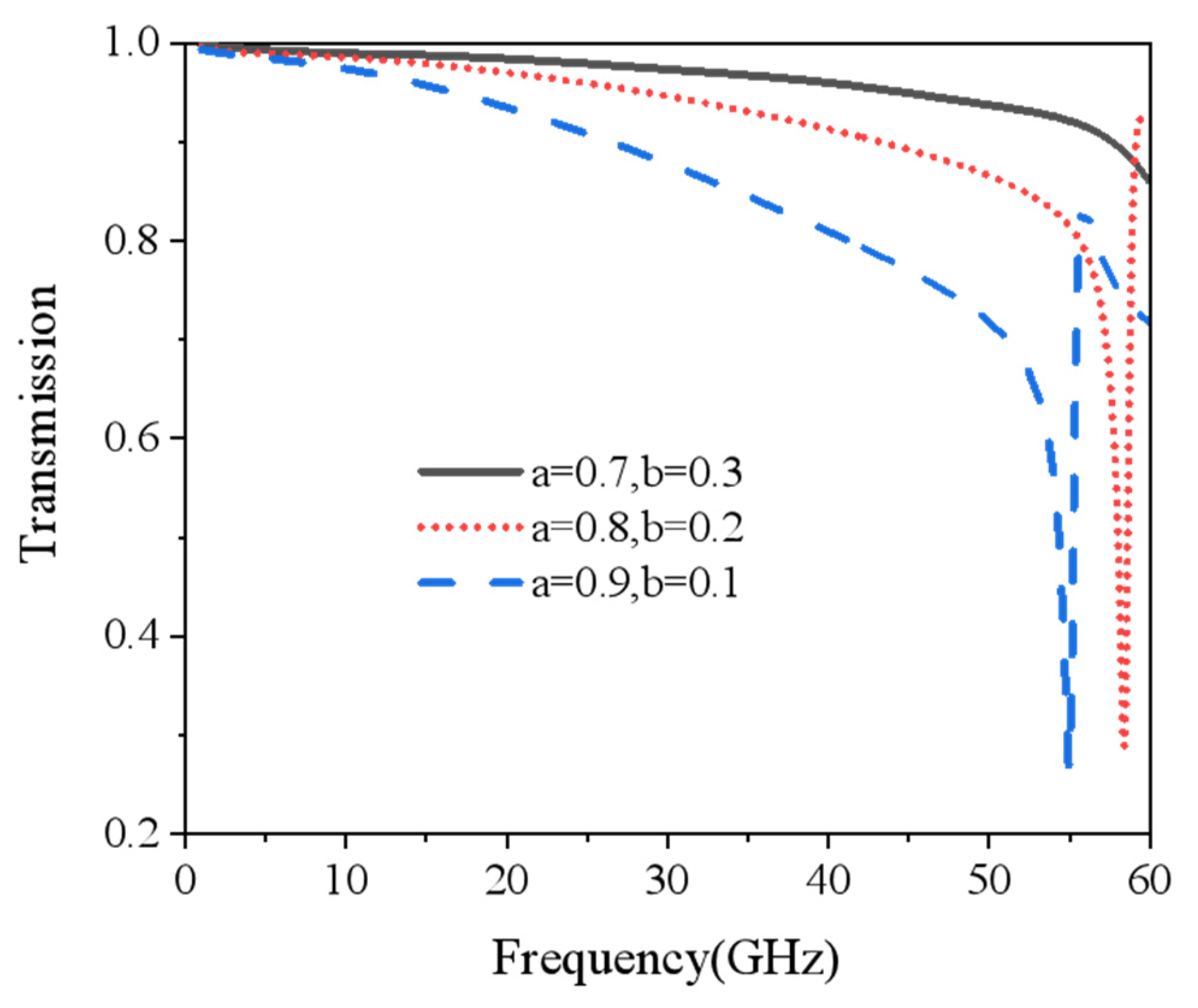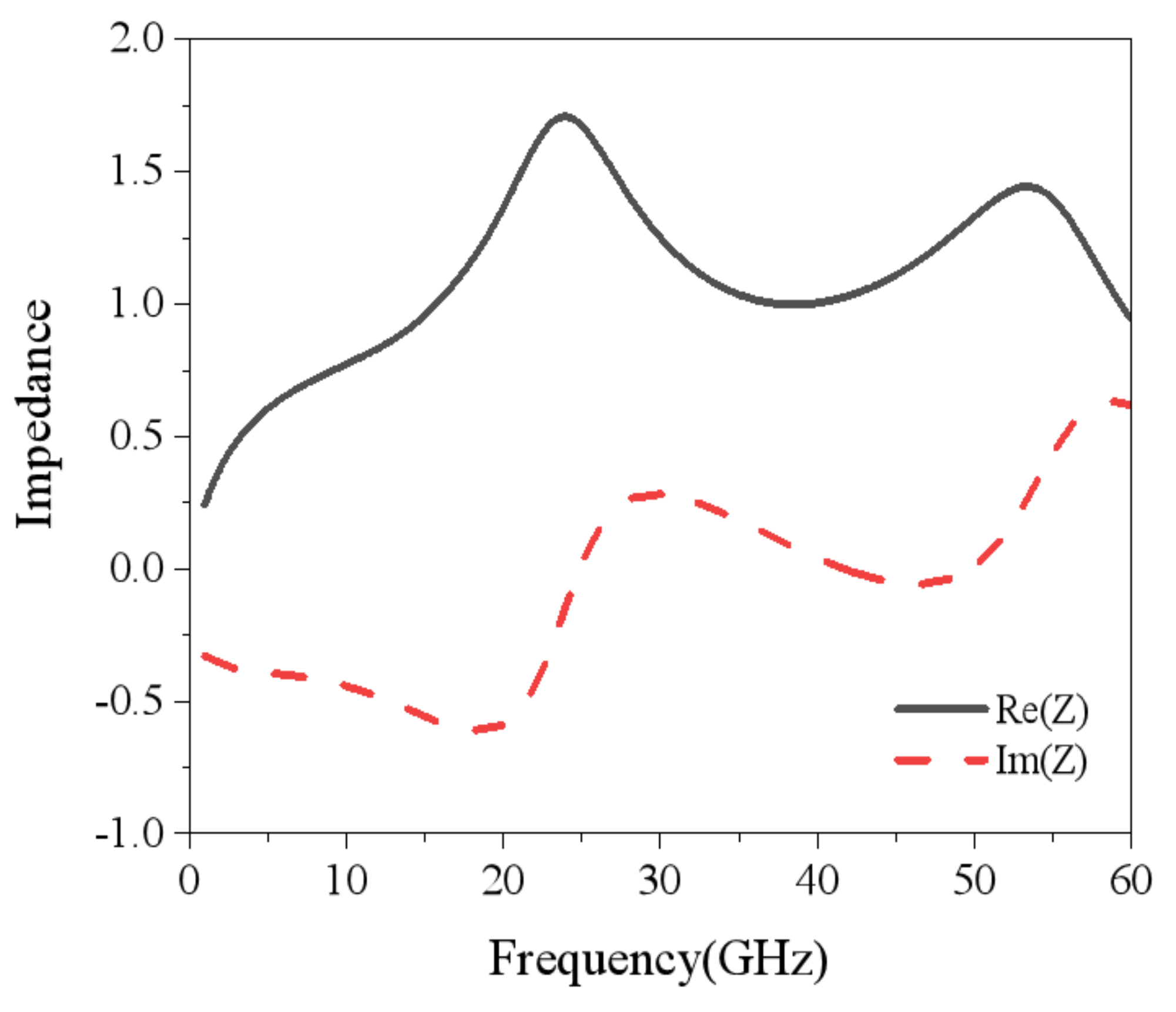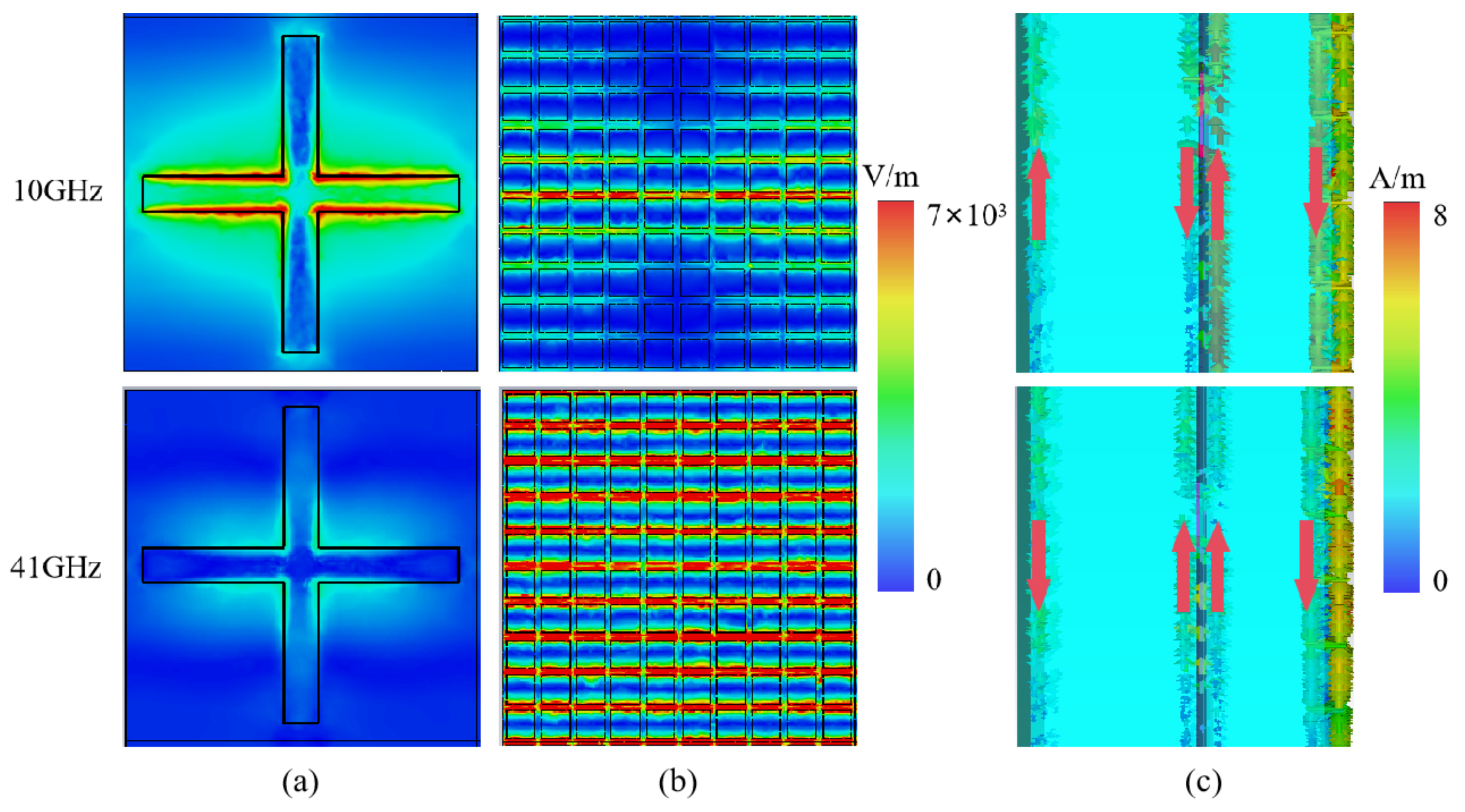Design of a Low-Infrared-Emission and Wideband-Microwave-Absorption Lightweight Metasurface
Abstract
1. Introduction
2. Structural Design
3. Results and Discussion
4. Conclusions
Author Contributions
Funding
Data Availability Statement
Conflicts of Interest
References
- Cao, F.; Liu, L.; Li, L. Short-wave infrared photodetector. Mater. Today 2023, 62, 327–349. [Google Scholar] [CrossRef]
- Li, Z.; Yan, T.; Fang, X. Low-dimensional wide-bandgap semiconductors for UV photodetectors. Nat. Rev. Mater. 2023, 8, 587–603. [Google Scholar] [CrossRef]
- Zhang, Y.; Zhou, S.; Tang, W.; Xu, Y.; Rui, Y.; Wang, W.; Yan, B.; Zhang, C.; Ye, Z.; Shi, H.; et al. Tamm-cavity terahertz detector. Nat. Commun. 2024, 15, 5542. [Google Scholar]
- Gao, X.; Xie, L. A scheme to detect the intensity of dusty weather by applying microwave radars and lidar. Sci. Total Environ. 2023, 859, 160248. [Google Scholar] [CrossRef]
- Lan, Z.; Lei, Y.; Chen, S.; Luo, D.; Zhu, F. Near-infrared and visible light dual-mode organic photodetectors. Sci. Adv. 2020, 6, 8065. [Google Scholar] [CrossRef]
- Wu, Y.; Tan, S.; Zhao, Y.; Liang, L.; Zhou, M.; Ji, G. Broadband multispectral compatible absorbers for radar, infrared and visible stealth application. Prog. Mater. Sci. 2023, 135, 101088. [Google Scholar]
- Astorino, M.D.; Fastampa, R.; Frezza, F.; Maiolo, L.; Marrani, M.; Missori, M.; Muzi, M.; Tedeschi, N.; Veroli, A. Polarization-maintaining reflection-mode THz time-domain spectroscopy of a polyimide based ultra-thin narrow-band metamaterial absorber. Sci. Rep. 2018, 8, 1985. [Google Scholar] [CrossRef] [PubMed]
- Caligiuri, V.; Pianelli, A.; Miscuglio, M.; Patra, A.; Maccaferri, N.; Caputo, R.; Luca, A.D. Near- and Mid-Infrared Graphene-Based Photonic Architectures for Ultrafast and Low-Power Electro-Optical Switching and Ultra-High Resolution Imaging. ACS Appl. Nano Mater. 2020, 3, 12218–12230. [Google Scholar]
- Qin, Z.; Zhang, C.; Liang, Z.; Meng, D.; Shi, X.; Yang, F. Thin Multispectral Camouflage Absorber Based on Metasurfaces with Wide Infrared Radiative Cooling Window. Adv. Photonics Res. 2022, 3, 2100215. [Google Scholar] [CrossRef]
- Huang, Y.; Zhu, Y.; Qin, B.; Zhou, Y.; Qin, R.; Ghosh, P.; Qiu, M.; Li, Q. Hierarchical visible-infrared-microwave scattering surfaces for multispectral camouflage. Nanophotonics 2022, 11, 3613–3622. [Google Scholar] [CrossRef]
- Qin, M.; Zhang, L.; Zhao, X.; Wu, H. Defect Induced Polarisation Loss in Multi-Shelled Spinel Hollow Spheres for Electromagnetic Wave Absorption Application. Adv. Sci. 2021, 8, 2004640. [Google Scholar] [CrossRef] [PubMed]
- Han, H.; Li, Y.; Lou, Z. Multi-interface engineering design of nitrogen-doped bamboo-based carbon/Fe/Fe3C composite electromagnetic wave absorber based on honeycomb-ant nest-like structure. Compos. Commun. 2024, 51, 102040. [Google Scholar] [CrossRef]
- Li, X.; Liu, S.; Meng, X.; Zhang, S.; Yu, M.; Wu, L.; Liang, X. Modified Antistatic Carbonaceous Fiber with Excellent Hydrophobicity, Environmental Stability and Radar Absorption Performance. Carbon 2024, 229, 119501. [Google Scholar]
- Blundell, S.J.; Blundell, K.M. Concepts in Thermal Physics; Oxford University Press Inc.: New York, NY, USA, 2006. [Google Scholar]
- Li, M.; Liu, D.; Cheng, H.; Peng, L.; Zu, M. Manipulating metals for adaptive thermal camouflage. Sci. Adv. 2020, 6, 3494. [Google Scholar]
- Peng, L.; Liu, D.; Cheng, H.; Zhou, S.; Zu, M. A Multilayer Film Based Selective Thermal Emitter for Infrared Stealth Technology. Adv. Opt. Mater. 2018, 6, 1801006. [Google Scholar] [CrossRef]
- Kluskens, M.S.; Newman, E.H. Scattering by a chiral cylinder of arbitrary cross section. IEEE Trans. Antennas Propag. 1990, 38, 1448–1455. [Google Scholar] [CrossRef]
- Wang, Y.; Cheng, H.F.; Wang, J.; Zhou, Y. Infrared emissivity of capacitive frequency-selective surfaces and its application in radar and IR compatible stealth sandwich structures. Adv. Mater. Res. 2012, 382, 65–69. [Google Scholar] [CrossRef]
- Ma, W.; Tang, C.; He, P.; Wu, X.; Cui, Z.K.; Lin, S.; Liu, X.; Zhuang, Q. Morphology-controlled fabrication strategy of hollow mesoporous carbon spheres@f-Fe2O3 for microwave absorption and infrared stealth. ACS Appl. Mater. Interfaces 2022, 14, 34985–34996. [Google Scholar]
- Li, J.; Xu, Z.; Li, T.; Zhi, D.; Chen, Y.; Lu, Q.; Wang, J.; Liu, Q.; Meng, F. Multifunctional antimony tin oxide/reduced graphene oxide aerogels with wideband microwave absorption and low infrared emissivity. Compos. Part B Eng. 2022, 231, 109565. [Google Scholar]
- Ma, C.; Cheng, H.; Tang, G.; Xie, W. Research progress of infrared/radar compatible stealth materials. Mater. Rep. 2007, 21, 126–128. [Google Scholar]
- Cui, Y.; Wang, J.; Sun, H.; Zhu, Y.; Zhu, R.; Liu, T.; Wang, X.; Xu, C.; Wang, J.; Qu, S. Visible Transparent Wideband Microwave Meta-Absorber with Designable Digital Infrared Camouflage. Adv. Opt. Mater. 2023, 12, 2301712. [Google Scholar] [CrossRef]
- Kowerdziej, R.; Stańczyk, T.; Parka, J. Electromagnetic simulations of tunable terahertz metamaterial infiltrated with highly birefringent nematic liquid crystal. Liq. Cryst. 2015, 42, 430–434. [Google Scholar] [CrossRef]
- Ramachandran, T.; Faruque, M.R.; Islam, M.T.; Khandaker, M.U.; Almugren, K.S. Development of diverse coding metamaterial structure for radar cross section reduction applications. Sci. Rep. 2022, 12, 10958. [Google Scholar]
- Meng, Z.; Liu, D.; Xu, C.; Wang, J.; Pang, Y.; Yang, J.; Li, X.; Gui, B.; Cheng, H. Multifunctional integrated metamaterials for radar-infrared-visible compatible multispectral stealth. Opt. Express 2024, 32, 17869–17878. [Google Scholar] [PubMed]
- Zhang, Z.; Wang, Q.; Li, Z.; Zhou, Z.; Xie, X.; Sun, H.; Chen, C.; Wang, M.; Dong, X.; Wu, Y.; et al. A skin-beyond multifrequency camouflage system with self-adaptive discoloration and radar-infrared stealth. Chem. Eng. J. 2024, 494, 152867. [Google Scholar]
- Gao, Y.; Jing, H.; Wang, J.; Kang, J.; Zhao, L.; Chen, L.; Wang, Y.; Duan, J.; Qu, Z.; Zhang, B. A transparent broadband flexible metamaterial absorber for radar infrared-compatible stealth. J. Phys. D Appl. Phys. 2024, 57, 155102. [Google Scholar]
- West, P.R.; Ishii, S.; Naik, G.V.; Emani, N.K.; Shalaev, V.M.; Boltasseva, A. Searching for better plasmonic materials. Laser Photonics Rev. 2010, 4, 795–808. [Google Scholar]
- Bandhu, H.; Ashok, P.; Verma, A. Active and passive infrared emittance tuning using optically transparent un-patterned ITO thin films. Opt. Mater. 2024, 157, 116181. [Google Scholar]
- Zhang, W.; Wang, T.; Zhong, L.; Wu, X.; Cui, M. Theoretical study of infrared emissivity of ITO conductive film. Acta Phys. Sin. 2005, 54, 4439–4444. [Google Scholar]
- Vilca-Huayhua, C.A.; Mishra, S.; Martinez, M.A.R.; Guerra, J.A.; Villegas-Lelovsky, L.; Aragón, F.F.H.; Coaquira, J.A.H. Tailoring structural, electrical, and optical properties of ITO thin films via vacuum-pressure annealing: An experimental and theoretical study. J. Alloys Compd. 2025, 1017, 178909. [Google Scholar] [CrossRef]
- Chen, Q.; Gong, T.; Chen, W.; Fang, F.; Feng, Y.; Chen, S.; Liu, D.; Liu, T. Rapid annealing obtained ITO films with both extremely low infrared emissivity and high visible light transmission for energy-efficient window applications. Ceram. Int. 2025, 51, 3163–3169. [Google Scholar]
- Carver, K.; Mink, J. Microstrip antenna technology. IEEE Trans. Antennas Propag. 1981, 29, 2–24. [Google Scholar] [CrossRef]
- Tian, H.; Liu, H.; Cheng, H. A thin radar-infrared stealth-compatible structure: Design, fabrication, and characterization. Chin. Phys. B 2014, 23, 025201. [Google Scholar]
- Costa, F.; Monorchio, A.; Manara, G. Analysis and design of ultra-thin electromagnetic absorbers comprising resistively loaded high impedance surfaces. IEEE Trans. Antennas Propag. 2010, 58, 1551–1558. [Google Scholar]
- Smith, D.R.; Vier, D.C.; Koschny, T.; Soukoulis, C.M. Electromagnetic parameter retrieval from inhomogeneous metamaterials. Phys. Rev. E 2005, 71, 036617. [Google Scholar] [CrossRef]
- Xu, C.; Wang, B.; Yan, M.; Pang, Y.; Wang, W.; Meng, Y.; Wang, J.; Qu, S. An optical-transparent metamaterial for high-efficiency microwave absorption and low infrared emission. J. Phys. D Appl. Phys. 2020, 53, 135109. [Google Scholar] [CrossRef]
- Huang, S.; Fan, Q.; Xu, C.; Wang, B.; Wang, J.; Yang, B.; Tian, C.; Meng, Z. A visible-light-transparent camouflage-compatible flexible metasurface for infrared–radar stealth applications. J. Phys. D Appl. Phys. 2021, 54, 015001. [Google Scholar] [CrossRef]
- Jing, H.; Wei, Y.; Kang, J.; Song, C.; Deng, H.; Duan, J.; Qu, Z.; Wang, J.; Zhang, B. An optically transparent flexible metasurface absorber with broadband radar absorption and low infrared emissivity. J. Phys. D Appl. Phys. 2023, 56, 115103. [Google Scholar]
- Duan, J.; Hao, J.; Wang, J.; Qu, Z.; Zhang, B. Transparent radar-infrared stealth based on multilayer metamaterial structures. Phys. Scr. 2023, 98, 055512. [Google Scholar] [CrossRef]
- Yang, J.; Zhao, J.; Li, X.; Guo, Y.; Wang, X.; Qiu, Y.; Li, B.; Wang, Z.; Li, W.; Yu, Y. Multifunctional-hierarchical flexible metasurface with simultaneous low infrared emissivity, broadband microwave absorption, and dynamic visible camouflage. Opt. Express 2024, 32, 38477–38489. [Google Scholar] [CrossRef]








| Absorbers | Absorption Bandwidth (GHz) | Relative Bandwidth (%) | Infrared Emissivity | Thickness (mm) |
|---|---|---|---|---|
| [37] | 6–18 | 100 | 0.3 | 7 |
| [38] | 8.27–17.65 | 72.4 | 0.27 | 2.9 |
| [39] | 1.98–18.6 | 161.5 | 0.28 | 9.5 |
| [40] | 2.12–15.87 | 152.9 | 0.25 | 9 |
| [41] | 2.53∼34.56 | 172.7 | 0.23 | 11.5 |
| This study | 7–58 | 157 | 0.36 | 1.7 |
Disclaimer/Publisher’s Note: The statements, opinions and data contained in all publications are solely those of the individual author(s) and contributor(s) and not of MDPI and/or the editor(s). MDPI and/or the editor(s) disclaim responsibility for any injury to people or property resulting from any ideas, methods, instructions or products referred to in the content. |
© 2025 by the authors. Licensee MDPI, Basel, Switzerland. This article is an open access article distributed under the terms and conditions of the Creative Commons Attribution (CC BY) license (https://creativecommons.org/licenses/by/4.0/).
Share and Cite
Liu, L.; Chen, Z.; Li, Z.; Chang, Y.; Li, P.; Liu, X.; Deng, X.; Feng, Y. Design of a Low-Infrared-Emission and Wideband-Microwave-Absorption Lightweight Metasurface. Nanomaterials 2025, 15, 399. https://doi.org/10.3390/nano15050399
Liu L, Chen Z, Li Z, Chang Y, Li P, Liu X, Deng X, Feng Y. Design of a Low-Infrared-Emission and Wideband-Microwave-Absorption Lightweight Metasurface. Nanomaterials. 2025; 15(5):399. https://doi.org/10.3390/nano15050399
Chicago/Turabian StyleLiu, Liping, Zongsheng Chen, Zhigang Li, Yajing Chang, Pengfei Li, Xun Liu, Xuesong Deng, and Yunsong Feng. 2025. "Design of a Low-Infrared-Emission and Wideband-Microwave-Absorption Lightweight Metasurface" Nanomaterials 15, no. 5: 399. https://doi.org/10.3390/nano15050399
APA StyleLiu, L., Chen, Z., Li, Z., Chang, Y., Li, P., Liu, X., Deng, X., & Feng, Y. (2025). Design of a Low-Infrared-Emission and Wideband-Microwave-Absorption Lightweight Metasurface. Nanomaterials, 15(5), 399. https://doi.org/10.3390/nano15050399






